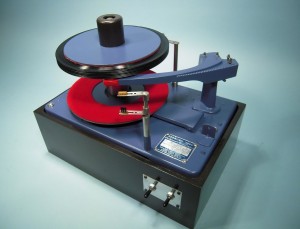Goodbye Flash!
www.txsound.com
Equipment details, resume details, clips and more. Thanks for visiting!
Monthly Archives: February 2012
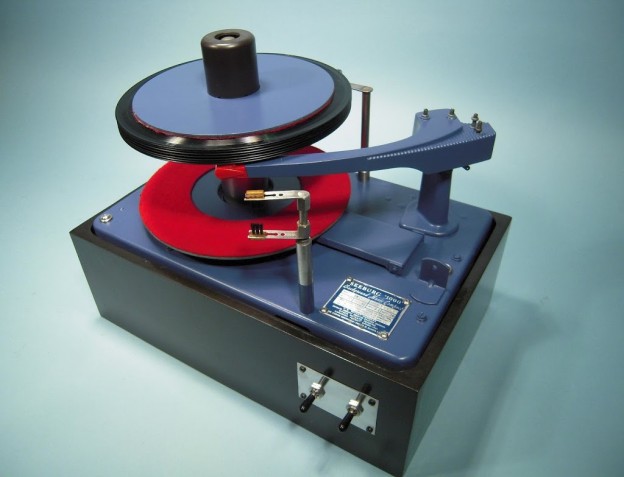
Seeburg 1000 Restoration Complete!
Record changers are fascinating mechanisms from the recent past. Older folks take them for granted.
Audiophiles, enamored with vinyl, disdain changers. Noisy, common, abusive to records.
That’s a shame. From a younger person’s perspective, they are graceful and robotic. They are a pleasure to watch. It’s like contemplating a lawn sprinkler, relaxing and strangely entertaining. And with the Seeburg, you’ll hear retro background tracks, music not intended to be heard above the department store din.
These selections, however, was laboriously written and recorded, one piece at a time, by real, work-a-day musicians. There’s excellence in the execution of these pieces. The recordings are solid and consistent. And, there’s lots of improvised solos and seemingly, entirely improvised pieces. Some of the solos are pretty wild, especially for what is supposed to be background music. Listen to the final number in the demo video below.
I am fascinated by devices such as this Seeburg 1000 changer. Not intented for general use or consumption by the public. Intended to be hidden in a closet at the back of the store. Built like a tank, to work all day long, every day, for years. The machine has many patents, all of them searchable on google patents.
For the uninitiated, here’s the basic introduction….
The Seeburg 1000 Background Music System is a phonograph designed and built by the Seeburg Corporation to play background music from special 16 2/3 RPM vinyl records in offices, restaurants, retail businesses, factories and similar locations. It provided a service similar to that of Muzak. A full load of records, played all the way through, yields a about a 1000 selections, hence the name.
This restoration was from a unit that was water damaged. The “compact” case that these turntables were built into are unattractive and have an awkwardly functioning door. This one’s cabinet was quite rusted, and so I constructed a base to better appreciate the mechanism. The unit was also available in an metal, chrome and glass cabinet, about the size of a large microwave oven. While certainly attractive, these cabinets take up a huge footprint, and again limit the appreciation of the Seeburg 1000’s form and function.
I don’t remember how I stumbled across these unusual players from the 60’s. But I happened across this decrepit example of a Seeburg 1000 BMC player on ebay, and the seller lived in Austin. We got together at the Vintage Radio Society Convention and Auction last November, and he sold this to me in its original form for about $100.
-by Pete Verrando
Please visit my website www.txsound.com
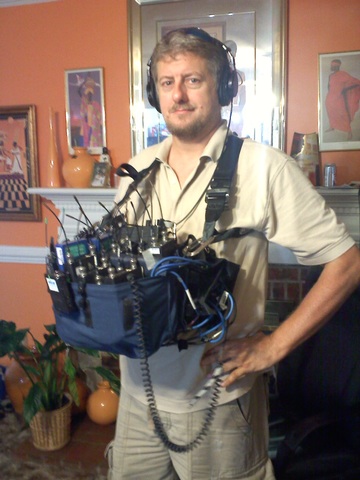
Get this thing off my chest.
The following is a rant that probably won’t be understood by anyone outside of production audio….
I think the size of a sound bag may relate to the mixer’s self-esteem, or lack of it.
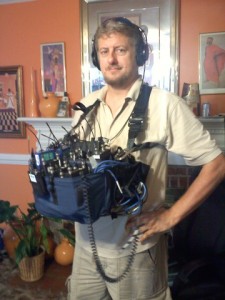 |
| ooooh, that’s a big bag…. |
Even with the latest equipment getting smaller and smaller, mixers are configuring their bags bigger and bigger. Some of these things weigh in at 30+ pounds. I don’t get it. One mixer told me “yeah, its a beast, but I get to sit down a lot.” This cracks me up. This kind of work is called “run & gun.” That means you should be able to run with it. And wear it like a gun. So you can run. And gun. Not sit. Maybe you can sit on this show, but what about the next?
There’s a lot of junk on board that you don’t need. There’s also the question of purchasing equipment with respect to size. The 788T is by far the smallest multitrack, but I think it lends itself to over-sized sound bags. Lots and lots of adaptor cables. A very weird footprint with the CL8. Kind of an upside-down L. The Zaxcom Fusion (thumping chest here) is physically bigger that the 788T, but lends itself to smaller kit size. And you don’t need an ipad to set levels and write sound reports. Where you gonna stow that? Yeah, yeah…,the Fusion’s more expensive. Given the money you’re already spending, it’s $2k or so that’s of little consequence.
You’d think the addition of IFB and hop transmitters to a sound bag blows away any chance of reduced size. Why would you pack a T1 (T4) IFB transmitter in a sound-bag? Its big. It’s RF output BNC is on the back, bleeding RF right next to the maze of cables down there. (See “garden hose comment below.)
The Lectro T4 draws 250ma of power, radiates RF like a son-va-bitch, and sits right on top of all your receivers. This leads to de-sensing the receivers and swamping the front ends. Frequency or block, it matters not. Why not a UM400, or better yet, an LMa? 70mw is plenty for IFB, in fact, its plenty for anything. Many mixers have a “CB radio” mentality about wireless power, but don’t get me started, that’s for another post. Anyway, T1’s and their ilk are too big. Replace it with something smaller, dude.
OK, everybody’s jumping on the SR receiver bandwagon. 2 receivers in one box. But wait- that’s a 401 level front end. And its a shared front end between 2 receivers- further compromising selectivity. You know what selectivity is, right? But who cares- its soooo small! I can have 8 receivers in one bag!
Oh wait- that reduced selectivity is giving me RF hell with my hops and my IFB transmitter. Hmmm. I guess I must redesign the front end of my SR’s (Did Lectro’s engineers do it wrong? )- by buying a bunch of splitters and RF amps and shorty cables and adaptors, and add me a couple a’ little ol’ LOG PERIODIC SHARK FIN ANTENNAS to my “run & gun” bag. Oh, and I need another 100ma of power for the RF preamps. And tie-wraps. Lots of tie-wraps.
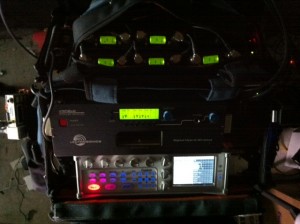 |
| Now there’s a back-breaker! |
By the way, RF acts just like water in a garden hose, right? All you need is valves, and hoses, and splitters and stuff to get it where you want it. Right? Oh wait, that’s another post…
BTW, watch out, I can only fit through a door one way now. But remember, I get to sit down. If not, I’m still young, so my back can take the weight.
What about power distro? Well, see, Remote Audio or BDS makes these cute little distro boxes. So, really, that’s the only way possible to distribute power to all my little toys. I have to add another box! With a bunch more little cables and connectors coming out of it! Why, its almost the same size as my Lectro T1. So, another layer of gear won’t protrude my kit out very far. I’ll just have to do some more crunches.
What if I had a simple power distro based on cables- soldered cables, and no box. I could just pull the battery out to power everything off. Hey, that’s one less box! And, without my Lectro T4, I almost don’ t need another row of stuff!
And hey, what if I’m not using receivers 6 thru and 8, like I do ten hours out of every 12 hour day. I could leave those receivers turned off. I’m saving power! And since my IFB is a LMa, I’m saving even more power! And since I’m not swamping my receivers with a TI, I don’t need all those splitters and preamps and cables and SHARK FIN ANTENNAS! I don’t even need to carry that 2nd battery!
I’ll stop here. Do you see the road I’m taking? There’s more to it, much more. But hey, you’ve got all that sitting time on the producer’s dime to figure this stuff out. Good times!
-by Pete Verrando
Please visit my website www.txsound.com

